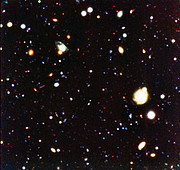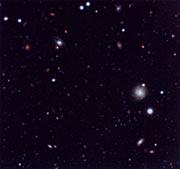Press Release
Deep Sky Diving with the ESO New Technology Telescope
Preparations for future cosmological observations with the VLT
13 January 1998
Within a few months, the first 8.2-meter Unit Telescope of the ESO Very Large Telescope (VLT) array will open its eye towards the sky above the Atacama desert. As documented by recent Press Photos from ESO, the construction work at the Paranal VLT Observatory is proceeding rapidly. Virtually all of the telescope components, including the giant Zerodur mirror, are now on the mountain.
While the integration of the telescope and its many optical, mechanical and electronic components continues, astronomers in the ESO member countries and at ESO are now busy defining the observing programmes that will be carried out with the new telescope, soon after it enters into operation. In this context, new and exciting observations have recently been obtained with the 3.5-m New Technology Telescope at the ESO La Silla Observatory, 600 km to the south of Paranal.
How to record the faintest and most remote astronomical objects
With its very large mirror surface (and correspondingly great light collecting power), as well as an unsurpassed optical quality, the VLT will be able to look exceedingly far out into the Universe, well beyond current horizons. The best technique to record the faintest possible light and thus the most remote celestial objects, is to combine large numbers of exposures of the same field with slightly different telescope pointing. This increases the total number of photons recorded and by imaging the stars and galaxies on different areas (pixels) of the detector, the signal-to-noise ratio and hence the visibility of the faintest objects is improved.
The famous Hubble Deep Field Images were obtained in this way by combining over 300 single exposures and they show myriads of faint galaxies in the distant realms of the Universe.
The NTT as test bench for the VLT
ESO is in the fortunate situation of possessing a `prototype' model of the Very Large Telescope, the 3.5-m New Technology Telescope. Many of the advanced technological concepts now incorporated into the VLT were first tested in the NTT. When this new facility entered into operation at La Silla in 1990, it represented a break-through in telescope technology and it has since then made many valuable contributions to front-line astronomical projects.
Last year, the control and data flow system at the NTT was thoroughly refurbished to the high VLT standards and current observations with the NTT closely simulate the future operation of the VLT. The successful, early tests with the new operations system have been described in eso9703.
The NTT SUSI Deep Field
With the possibility to test already now observing procedures which will become standard for the operation of the VLT, a group of astronomers [1] was granted NTT time for observations of Faint Galaxies in an Ultra-Deep Multicolour SUSI field . This is a programme aimed at the study of the distribution of faint galaxies in the field and of gravitational lensing effects (cosmic mirages and deformation of images of distant galaxies caused by the gravitational field of intervening matter). SUSI (SUperb Seeing Imager) is a high-resolution CCD-camera at the NTT that is particularly efficient under excellent sky conditions.
The observations were fully defined in advance and were carried out in service mode from February to April 1997 with flexible scheduling by a team of dedicated ESO astronomers (the NTT team). Only in this way was it possible to obtain the exposures under optimal atmospheric conditions, i.e. `photometric' sky and little atmospheric turbulence (seeing better than 1 arcsec).
A total of 122 CCD frames were obtained in four colours (blue, green-yellow, red and near-infrared) with a total exposure time of no less than 31.5 hours. The frames cover a 2.3 x 2.3 arcmin `empty' sky field centered south of the high-redshift quasar QSO BR 1202-0725 (z=4.7), located just south of the celestial equator.
The frames were computer processed and combined to yield a colour view of the corresponding sky field.
This is indeed a very deep look into the southern sky. The astronomers have found that the limiting magnitude (at a signal-to-noise ratio of 3) is beyond 27 in the blue and red frames and only slightly brighter in the two others. Magnitude 27 corresponds to a brightness that is 250 million times fainter than what can be perceived with the unaided eye. Although not as deep as the Hubble Deep Field due to the shorter exposure time and brighter sky background (caused by light emission in the upper layers of the terrestrial atmosphere), this new set of data is among the best ground-based observations of this type ever obtained.
Galaxies down to a magnitude of roughly 25 will soon be targets of detailed spectroscopic observations with the VLT. They will provide a measure of their basic physical parameters like redshift, luminosity and mass.
How to access the new data
This scientific program aims at the study of the photometric redshift distribution of the faint galaxies [2] and of gravitational lensing effects (cosmic mirages). It has been decided to make the complete data set available to the wide scientific community and it is expected that many astronomers all over the world will want to perform their own investigations by means of this unique observational material.
A full description of the project is available on the ESO Web at THE NTT SUSI Deep Field. Here you will find a comprehensive explanation of the scientific background, details about the observations and the data reduction, as well as easy access to the corresponding data files.
Notes
[1] The group consists of Sandro D'Odorico (Principal Investigator, ESO) and Jacqueline Bergeron (ESO), Hans-Martin Adorf (ESO), Stephane Charlot (IAP, Paris, France), David Clements (IAS, Orsay, France), Stefano Cristiani (Univ. of Padova, Italy), Luiz da Costa (ESO), Eiichi Egami (MPI Extraterrestrial Physics, Garching, Germany), Adriano Fontana (Rome Observatory, Italy), Bernard Fort (Paris Observatory, France), Laurent Gautret (Paris Observatory, France), Emanuele Giallongo (Rome Observatory, Italy), Roberto Gilmozzi, Richard N.Hook and Bruno Leibundgut (ESO), Yannick Mellier and Patrick Petitjean (IAP, Paris, France), Alvio Renzini, Sandra Savaglio and Peter Shaver (ESO), Stella Seitz (Munich Observatory, Germany) and Lin Yan (ESO).
[2] The photometric redshift method allows to determine an approximate distance of a distant galaxy by measuring its colour, i.e., its relative brightness (magnitude) in different wavebands. It is based on the proportionality between the distance of a galaxy and its recession velocity (the Hubble law). The higher the velocity, the more its emission will be shifted towards longer wavelengths and the redder is the colour. Recent investigations of galaxies seen in the Hubble Deep Field have shown that the redshifts (and thus distances) found by this method are quite accurate in most cases.
About the Release
| Release No.: | eso9801 |
| Legacy ID: | PR 01/98 |
| Name: | NTT Susi Deep Field |
| Type: | Early Universe : Galaxy : Grouping : Cluster |
| Facility: | New Technology Telescope |
| Instruments: | SUSI |
Our use of Cookies
We use cookies that are essential for accessing our websites and using our services. We also use cookies to analyse, measure and improve our websites’ performance, to enable content sharing via social media and to display media content hosted on third-party platforms.
ESO Cookies Policy
The European Organisation for Astronomical Research in the Southern Hemisphere (ESO) is the pre-eminent intergovernmental science and technology organisation in astronomy. It carries out an ambitious programme focused on the design, construction and operation of powerful ground-based observing facilities for astronomy.
This Cookies Policy is intended to provide clarity by outlining the cookies used on the ESO public websites, their functions, the options you have for controlling them, and the ways you can contact us for additional details.
What are cookies?
Cookies are small pieces of data stored on your device by websites you visit. They serve various purposes, such as remembering login credentials and preferences and enhance your browsing experience.
Categories of cookies we use
Essential cookies (always active): These cookies are strictly necessary for the proper functioning of our website. Without these cookies, the website cannot operate correctly, and certain services, such as logging in or accessing secure areas, may not be available; because they are essential for the website’s operation, they cannot be disabled.
Functional Cookies: These cookies enhance your browsing experience by enabling additional features and personalization, such as remembering your preferences and settings. While not strictly necessary for the website to function, they improve usability and convenience; these cookies are only placed if you provide your consent.
Analytics cookies: These cookies collect information about how visitors interact with our website, such as which pages are visited most often and how users navigate the site. This data helps us improve website performance, optimize content, and enhance the user experience; these cookies are only placed if you provide your consent. We use the following analytics cookies.
Matomo Cookies:
This website uses Matomo (formerly Piwik), an open source software which enables the statistical analysis of website visits. Matomo uses cookies (text files) which are saved on your computer and which allow us to analyze how you use our website. The website user information generated by the cookies will only be saved on the servers of our IT Department. We use this information to analyze www.eso.org visits and to prepare reports on website activities. These data will not be disclosed to third parties.
On behalf of ESO, Matomo will use this information for the purpose of evaluating your use of the website, compiling reports on website activity and providing other services relating to website activity and internet usage.
Matomo cookies settings:
Additional Third-party cookies on ESO websites: some of our pages display content from external providers, e.g. YouTube.
Such third-party services are outside of ESO control and may, at any time, change their terms of service, use of cookies, etc.
YouTube: Some videos on the ESO website are embedded from ESO’s official YouTube channel. We have enabled YouTube’s privacy-enhanced mode, meaning that no cookies are set unless the user actively clicks on the video to play it. Additionally, in this mode, YouTube does not store any personally identifiable cookie data for embedded video playbacks. For more details, please refer to YouTube’s embedding videos information page.
Cookies can also be classified based on the following elements.
Regarding the domain, there are:
- First-party cookies, set by the website you are currently visiting. They are stored by the same domain that you are browsing and are used to enhance your experience on that site;
- Third-party cookies, set by a domain other than the one you are currently visiting.
As for their duration, cookies can be:
- Browser-session cookies, which are deleted when the user closes the browser;
- Stored cookies, which stay on the user's device for a predetermined period of time.
How to manage cookies
Cookie settings: You can modify your cookie choices for the ESO webpages at any time by clicking on the link Cookie settings at the bottom of any page.
In your browser: If you wish to delete cookies or instruct your browser to delete or block cookies by default, please visit the help pages of your browser:
Please be aware that if you delete or decline cookies, certain functionalities of our website may be not be available and your browsing experience may be affected.
You can set most browsers to prevent any cookies being placed on your device, but you may then have to manually adjust some preferences every time you visit a site/page. And some services and functionalities may not work properly at all (e.g. profile logging-in, shop check out).
Updates to the ESO Cookies Policy
The ESO Cookies Policy may be subject to future updates, which will be made available on this page.
Additional information
For any queries related to cookies, please contact: pdprATesoDOTorg.
As ESO public webpages are managed by our Department of Communication, your questions will be dealt with the support of the said Department.


